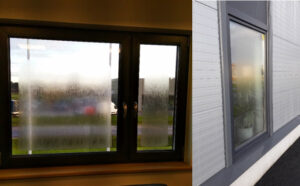Useful to know
The selection of different plastic windows is wide. The most important aspects in case of windows are the thermal performance, opening possibilities and colour.
With the following we will try to be of assistance to you by giving simple recommendations for making the best choices and submitting a price enquiry in the ,,Submit a price enquiry’’ module.
Thermal performance
We make plastic windows with different thermal performance and therefore need to know for which building the windows are intended. The thermal performance of windows is measured with a U-value*. The lower the value, the greater the thermal performance of a window. If you need windows to be installed in a non-heated room or into rooms with low thermal demand, an excellent thermal performance of windows is not important. For that purpose we recommend our Standard window (70 mm profile and double glazing with selective glass* – Uw=1.4W/m2K). If you need windows for a properly insulated building, our recommendation is the SYNEGO profile system (80 mm profile and triple glazing with two selective glasses – Uw=0.88W/m2K). In case of a passive house we recommend the GENEO profile system (86 mm thick profile and triple glazing with two selective glasses – Uw=0.78W/m2K).
A few explanations:
1) U-value* shows how many W (watts) of thermal energy per hour transfers from a room through one square metre of window space. The Uw (window) values of windows have been indicated above. In order to comprehend the essence of the specified numbers in more detail, here are a few examples:
a) U-value of an uninsulated large-panel building wall = 0.5 to 0.7 W/m2
b) U-value of an insulated large-panel building wall = 0.3 to 0.5 W/m2
c) U-value of buildings from modern materials = 0.2 W/m2
* the given numbers are average indicators, and different buildings have certainly somewhat different thermal performance indicators.
NB! As a rule the thermal performance of windows is lower than the thermal performance of walls of a building but the difference in the performance could be smaller if possible – you just need to choose the windows with the best indicators!
SYNEGO profile system gives you the best price to quality ratio.
2) Selective glass* – bright glass with a thin layer of metal applied on the internal side of the glazing which reflects the indoor heat (thermos effect).
Opening possibilities
Windows can be made as non-opening and opening (opening inward as a rule). You need to make your choice according to the need. Certainly, non-opening windows are cheaper than opening windows but your choice should not be based on that alone. Window opening possibilities are as follows:
a) Turn position – the window opens from the side
b) Tilt position – the window only opens ca 10 cm above for ventilation
c) Turn and tilt position – the window can be opened completely and put in the ventilation position as well
When choosing windows, in addition to the need to ventilate, you should also account for the need to wash i.e even if you don’t need to open the window for other reasons, you still need to wash them.
Colour of windows
As a rule, a window is white from the inside and outside. However, the colour range of windows is extensive. As on the computer screen the colours seem somewhat different from the actual, our recommendation is to make the final decision on the colour by examining the samples with our sales representative. You may choose the colour in the price enquiry and change it later if necessary.
To conclude:
Now that the basic things concerning windows have been explained, you need to think about the works connected with the installation of windows. The whole process includes the following works:
1) Removal of old windows and installation of new ones.
2) Finishing of external window jambs – new corner flashings will be installed or something else depending on the specific nature of the object. It will be specified in more detail on site.
3) Installation of new internal window sills.
4) Finishing of internal window jambs (e.g plastic enclosures)
5) Utilization of old windows and other construction waste.
The works specified above can be ordered in aggregate or in parts.
Of course you will have other questions relating to the selection and replacement of windows (security glasses, special-shape windows, insect nets etc.), but these can already be discussed with our sales representatives in more detail or you can list your requests under the field ,,Additions, special requests” at the end of the price enquiry.
The above should suffice to understand the offered products and services and to make your initial selection.
Now you can submit us a price enquiry after which we shall be in contact with you.
Submit a price enquiry

 Reasons
Reasons